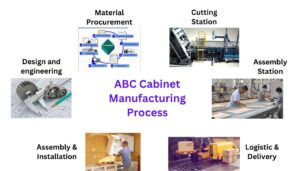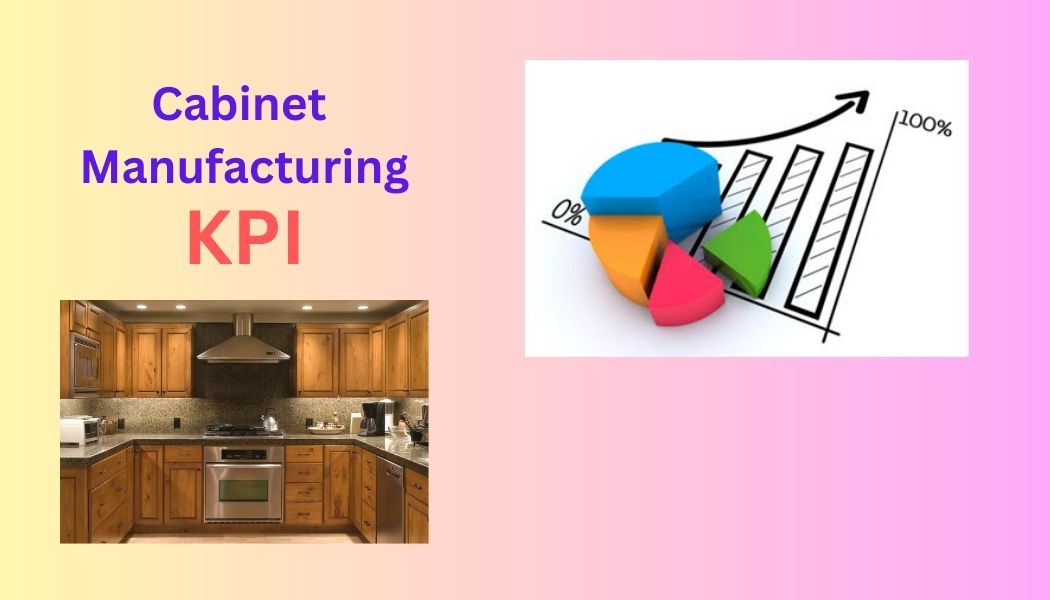Key Performance Indicators (KPIs) play a crucial role in assessing the effectiveness and efficiency of various processes within a manufacturing facility. Manufacturers obtain valuable insight to optimize their operations, enhance productivity, and deliver high-quality products by carefully selecting and measuring the right KPI. In this article, l illustrates the process to follow to determine the best manufacturing KPI for your industry through a case study of a cabinet manufacturing.
How to determine the right metrics?
The selection of manufacturing KPI is not a one-time process. It requires ongoing evaluation, refinement, and adaptation to align with the evolving needs in the way described in “The Importance of Continuous Process Improvement”. The figure illustrates the process.
Process to determine the manufacturing KPI of a cabinet maker industry
To determine the appropriate set of manufacturing KPI, you do need to understand very well the specifics of the business and its current situation. And that is what we did in the case we will analyze, which is a cabinet manufacturing. In this section we summarize the process followed. This section covers the steps to cover.
Knowing the company
ABC Cabinet Inc. designs and manufactures cabinets for homes and buildings. Most of his customers are property management companies but they also serve individual customers. The company is considered by its peers as a high-quality company. Prospects come mainly from word of mouth and alliances with developers and property management companies.
Learning the manufacturing process
You create a comprehensive map of your cabinet manufacturing process, outlining all the stages involved, from design and procurement to production, quality control, and delivery. The figure below summarizes the cabinet manufacturing process.

Stakeholder engagement
The process of selecting KPIs requires the involvement of the Stakeholders. Their expertise and insights will provide a well-rounded perspective and ensure that all relevant aspects are considered. Through the sessions with the stakeholder, we learned that, even though their sales were good, they were barely above breakeven, and the cash flow cycle had little slack. The company used QB enterprise and manufacturing software for the cutting machine.
Situational analysis
As a result of the floor plant evaluation, we draw the following conclusions:
- The configuration of the cutting machine software only considered operating the machine but with little data generation. After the software reconfiguration, we found out that:
- The machine utilization was below standards, mainly because the time to deliver and install the products was considerably longer than the production time.
- The cutting error rate was relatively high.
- There was a lag between raw material procurement and production time, resulting in longer delivery times than agreed with the customers.
- There was not enough clarity on the impact of returns and wrong cuts on the gross profit.
Build the KPIs that addresses the variables affecting profits and cash flow
This is the subject of the next section
Manufacturing KPI for a cabinet industry
| Material Procurement | Material Cost Variance | Measures the variance between the estimated material cost and the actual material cost | (Actual material cost – Estimated material cost) / Estimated material cost |
| Material Lead Time | Measures the time taken to procure materials from suppliers | Time of material delivery – Time of material order placement | |
| Production Efficiency | Cutting machine usage | Measures the proportion of the cutting machine used | Number of cut plates produced / Total cut capacity |
| Cutting Accuracy | Measures the proportion of wrong cuts made | Number of wrong cuts / Total cuts | |
| Assembly | Production Cycle Time | Measures the time taken to complete one full project cycle | Sum of the Time to complete each of the components of a project |
| First Pass Yield (FPY) | Measures the proportion of cabinets manufactured correctly in the first attempt, without rework or repairs | Number of defect-free cabinets / Total number of cabinets in the project | |
| Quality Control | Defect Rate | Measures the percentage of defective cabinets | Number of defective cabinets / Total number of cabinets in the project |
| Customer Return | Measures the number of cabinets returned by installers due to quality issues | Number of returned cabinets / Total number of cabinets in the project | |
| Logistic & Delivery | On-Time Delivery | Measures the percentage of projects delivered within the promised time frame | Number of projects delivered on time / Total number of projects delivered |
| Order Accuracy | Measures the percentage of projects delivered as per the customer’s order specifications | Number of projects delivered correctly / Total number of projects |
Importance of the right manufacturing KPI
Implementing appropriate KPIs in each stage of the cabinet manufacturing process allowed ABC to monitor their performance and identify areas for improvement. By regularly calculating and analyzing these KPIs, ABC could make data-driven decisions, optimize the operation, enhance productivity, reduce costs, and ultimately deliver high-quality products that meet customer expectations. However, remember that KPIs are not set in stone and can be customized to align with specific business objectives and priorities, helping cabinet manufacturers thrive in a competitive market.-
If you want to learn more about our services give us your information to schedule a meeting.
I hope this article has been helpful to you. I will continue to post information related to trade channel management, general economy and market trends. If you are interested in this article or want to learn more about Promoting USA, please subscribe to stay updated on future articles.
Subscribe to Promoting USA blog

